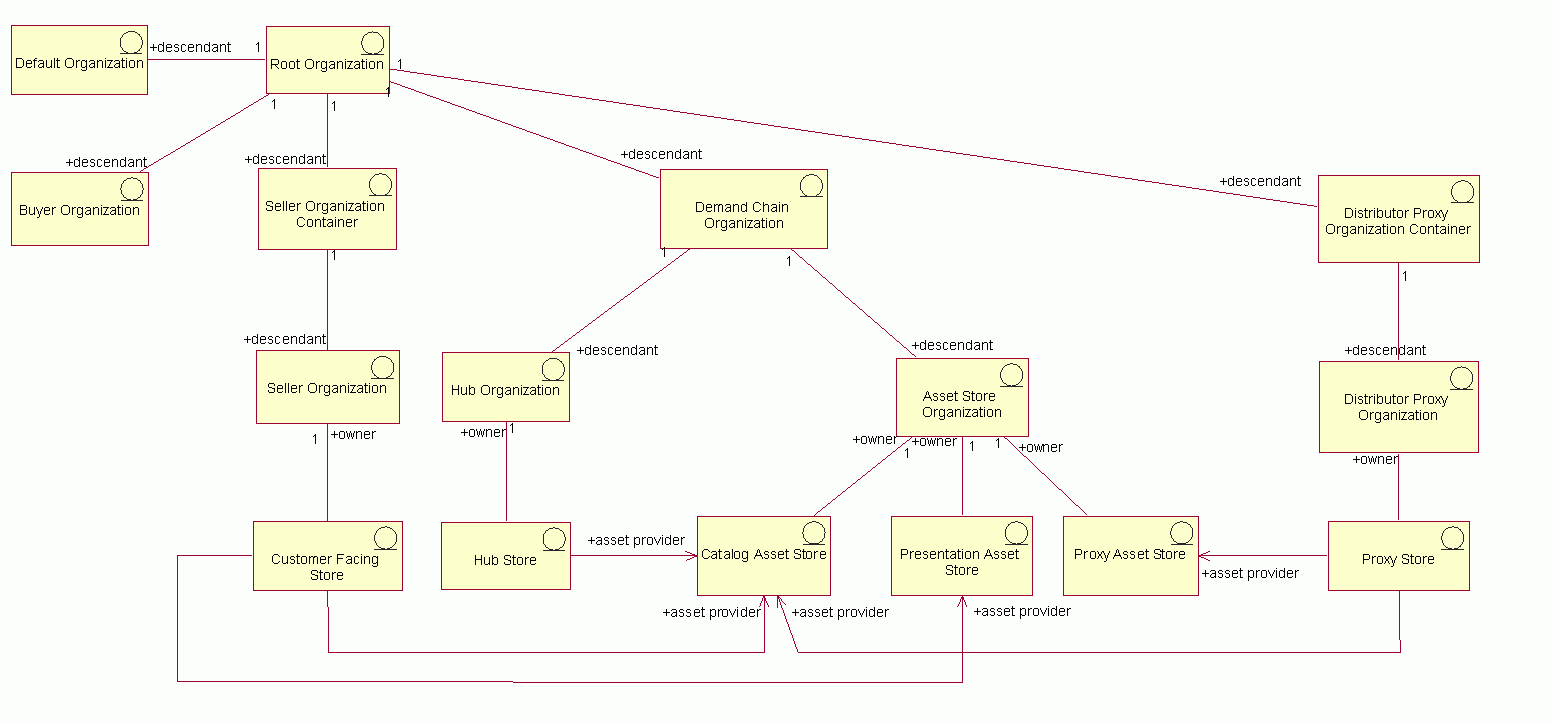Demand chain information model
A demand chain, one of the predefined business models in WebSphere Commerce, is composed of the enterprises that sell a business's goods or services. For example, a demand chain may be composed of buyers who initiate the sales transaction, the resellers who sell the manufacturer's goods, and the manufacturer who creates the goods. Or a demand chain may be composed of the resellers who sell a manufacturer's goods, the manufacturer who makes the goods, and the distributors who supply the manufacturer's goods to the resellers. Demand chains also support direct sales channels, in which the demand chain owner sells directly to consumers or business partners.
The following diagram shows a UML representation of the demand chain information model.

- Root Organization
- All organizations in the business become descendents of the root organization. As well, the administrators who will maintain the online site, the Site Administrators, are added directly under the root.
- Default Organization
- Customers who do not register as part of a buyer organization, but as individuals, belong to the default organization.
- Buyer Organization
- Customers, known in B2B businesses as buyers, are represented by a buyer organization. Individual users who belong to buyer organizations, must register under their respective organization.
- Seller Organization Container
- A Seller organization container holds any number of seller organizations. By having stores under different seller organizations, you have more flexibility in terms of access control for customers as well as administrators.
- Seller Organization
- The seller organization is created to own all of the stores. A child organization unit is created for each store.
- Demand Chain Organization
- The demand chain management organization owns all of the manufacturer related organizations.
- Hub Organization
- A child organization of the demand chain Organization. The demand chain hub organization is created to own the demand chain hub. The administrators who maintain the demand chain hub's functions, as well as administering the demand chain organization, are termed channel administrators and are owned directly by the demand chain hub organization.
- Hub Store
- A store which enables partners or clients. In the demand chain business model the hub store could be a store directory.
- Asset Store Organization
- The asset store organization is created to own all assets that are used to create stores for channel partners (resellers and distributors).
- Catalog Asset Store
- A catalog of goods for sale, containing pricing and currency information.
- Presentation Asset Store
- The Presentation Asset Store consists of Web assets such as HTML pages, JSP files, style sheets, images, graphics and other multimedia file types. You can also define shipping methods, shipping charges, marketing promotions, and contracts assets.
- Proxy Asset Store
- A proxy asset store is a store that represents a business partner's operational assets and provides the business logic that allows the WebSphere Commerce site to interact with an external business partner. The proxy store also contains operational data that gets updated in interaction with the business proxy site. For example, a proxy store may capture the orders transferred to a remote order capture system, as well as capturing the suppliers' inventory information or the information sent to a supplier's fulfillment centers. Unlike a customer-facing store, a proxy store does not include a storefront and cannot be accessed by users.
- Customer Facing Store
- An online site where users may obtain information regarding products, and conduct business transactions over these products. Business transactions may include retail purchases, transactions between businesses and transactions between a government organization and citizens or businesses. WebSphere Commerce uses the generic term 'store' to describe the online space where all of these business transactions take place.
- Proxy Store
- A proxy store is a store that represents a business partner's operational assets and provides the business logic that allows the WebSphere Commerce site to interact with an external business partner. The proxy store also contains operational data that gets updated in interaction with the business proxy site. For example, a proxy store may capture the orders transferred to a remote order capture system, as well as capturing the suppliers' inventory information or the information sent to a supplier's fulfillment centers. Unlike a customer-facing store, a proxy store does not include a storefront and cannot be accessed by users.
- Distributor Proxy Organization Container
- A Distributor Proxy Organization container holds any number of distributor organizations. By having stores under different distributor proxy organizations, you have more flexibility in terms of access control for customers as well as administrators.
- Distributor Proxy Organization
- The distributor proxy organization is created to own all distributor proxy stores. A child organizational unit is created for each distributor proxy in the organization.
Related concepts
Related reference